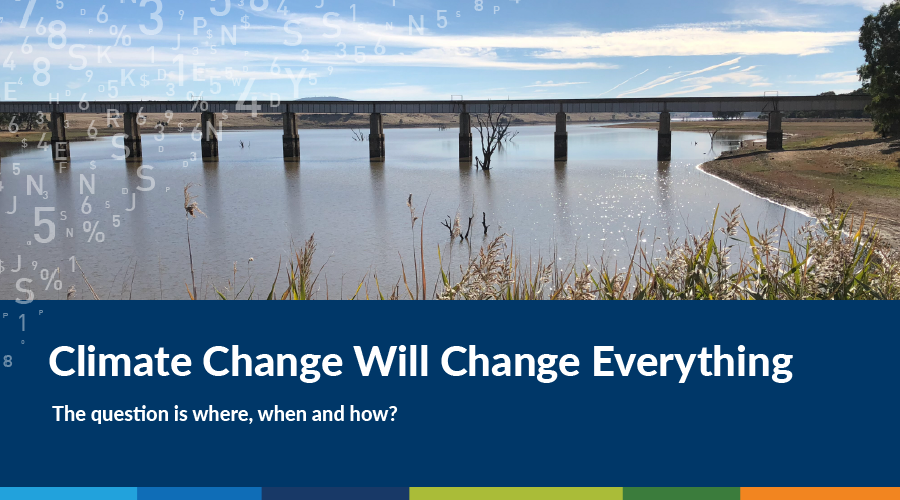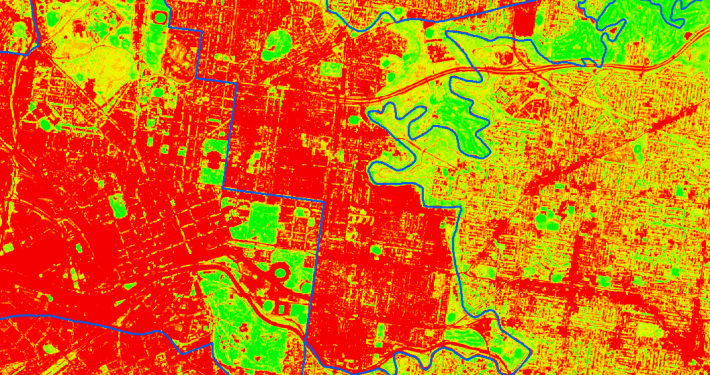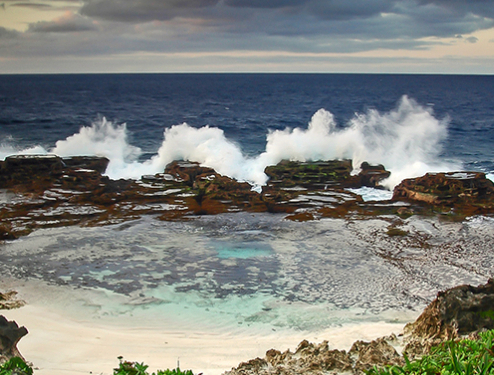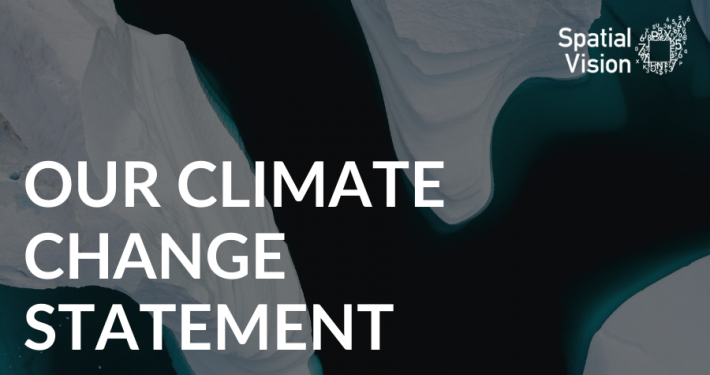There is no doubt that climate change is no longer just a threat, it is a real and present danger that is increasingly impacting the lives of many people and the natural world. The question is what are we doing about it?
I think the biggest challenge is leadership. When the Pope recently spoke to senior members of the petroleum industry and asked why they continued to spend so much effort finding new reserves of carbon polluting resources to dig up at a time when scientists had concluded the consequences for the planet and humankind of digging up any new reserves of carbon-based fuels will be dire, it begs the question of where is leadership on the issue? Thank you, Pope.
Increasingly, many people in the corporate sector have confirmed that it is financially irresponsible to expose assets to the real threat of climate change – be it investments, assets or production processes.


Figure 1: New Approaches to Climate Thinking and Risk Management – Prof Jean Palutikof, NCCARF director Climate Leadership Conference 2018 Sydney
Think Global, Act Local
One of these conferences was on leadership, with the clear message that rather than get distracted by the partisan climate change politics of the day at a state and federal government levels, we need to think in global and local terms. The message is that there has never been a more pressing issue around which to think global and act local. In terms of local, the message has been that we need to think, plan and act on cities, and liveability, since so many of us live in increasing urbanised and built environments.
The Lens of Climate Change
The other key message I took away from the conferences was that we should consider everything we plan to do and how we do it, through the lens of climate change. Climate change will change everything we know and have experienced until now. And what’s more, significant change is already locked in. We have already added the carbon emissions that will change the world’s climate over the next 20 years. So firstly, be prepared to deal with that – hence the raft of adaptation strategies that many organisations are now considering.
But most importantly decarbonize, decarbonize, decarbonize, so that we don’t continue to lock in more change. Not only decarbonise our energy production and consumption but decarbonise our product production processes. For example, we were told of the importance of decarbonising our current cement production processes, since cement production – as a key resource in the building of new cities to house the worlds growing population – is a major contributor to global carbon emissions. There was some amazing statistics along the lines’ China had used more cement in the 3 years (2011-2013) than the USA did in the entire 20th century.
We were also told of the tremendous efforts in understanding production processes, and refining or replacing the most carbon intensive polluting parts of the process. Work by groups like the CRC for Low Carbon Living was very impressive and encouraging.
There were also fascinating presentations on reducing the carbon emissions generated in the production of other products, such as smart phone components; or the changes already being observed in health and diseases as our climate changes. And there was no surprise to hear how many Defence forces have for some time accepted and have been applying scenarios relating to the likely impacts on anticipated climate change.
Starting at the bottom
I particularly liked the graphic related to the climate change activities relevant to the Great Barrier Reef by David Wachenfeld, GBRMA. The base of the triangle is tackle climate change (directly by reducing carbon emissions). Above that are changes in land management practices, and at the top point of the triangle were the adaptation strategies, such assisted gene flow, population relocation etc. The message was that we shouldn’t get distracted talking about how clever we may be in saving the last species of coral on the reef, we need to focus on decarbonizing at a broad and local level as the most important step we can undertake to help the reef, and then changes in land management practices.


Figure 2: Climate change activities relevant to the Great Barrier Reef by David Wachenfeld, GBRMA
How can spatial sciences and technologies help?
My particular interest was to better understand how spatial sciences and technologies can help us understand the likely impacts. Understand what will change, and by how much when, and which assets are more or less exposed? And rather than the traditional likelihood consequence matrix approaches to risk management, it seems we need to consider scenarios, and hence use spatial techniques to expose the what-ifs. What if there is an increased intensity and frequency of storms, and they come from a different direction? – such as the storms that hit Sydney’s coastline a few years ago – coming more from the east than the south east.


Figure 3: Coastal Impacts of the June 2016 East Coast Storm – Prof Ian Turner University of Sydney Climate Leadership Conference 2018 Sydney
A key theme in recent times has been the uncertainly in climate change forecasts. Which model, what assumptions, what timeframes etc. should be used? The message from these conferences was unequivocally that uncertainly is no excuse. Change is coming, get on and plan for it. There are tools and support available. Make sure that your assumptions and the data you use are clear or transparent and share what you do. As better tools and data become available the process can be repeated and refined. Another key message was that we are poor at predicting the extremes, the real events we experience are often worse than our worst case modelled scenarios. So, use the current scenarios in this context.
The power of spatial technologies is also assisting us better understand and plan for change in our cities – particularly their liveability and sustainability in a changing and more climate challenging world.
Identifying city footprints, or thermal heat distribution were two examples of spatial approaches to better understand and inform planning responses.




Figure 4 & 5:Towards a low carbon future – Scientia Prof Deo Prasad Low Carbon Living CRC Climate Leadership Conference 2018 Sydney
There were a couple of great presentations that highlighted how spatial technologies are increasingly applied to natural disasters, both in traditional ways, such as in the planning and being prepared, and to inform those of the threat and by emergency agencies to respond – but in increasingly innovative ways such as the harvesting of twitter feeds to the help track the fire front.
Climate change will change everything. It is a societal and moral challenge and dilemma. We can all play a role and do more. When future generations ask us where we were and what we did, I think we will want to feel comfortable with our answer.
The conferences were:
Climate Leadership conference in Sydney, 2018
Climate Adaption Conference in Melbourne, 2018




